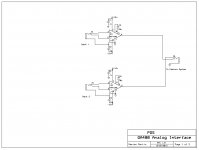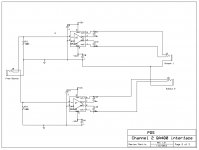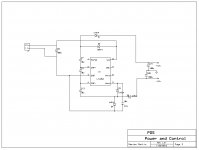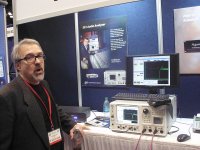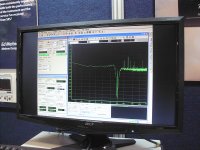Dog Biscuits vs. Percent
What are we looking at here Bear?
you mean under the ctr+click on the Gen1/2 that sets the freq and amplitude?
If so, I ought to *read* what is in front of my eyes for a change!
_-_-
Bear it the Windows drop down. Top left "Settings" Generator Fixed Tone.
Hi Demian, the .sch is blank.
I just checked the uploaded file. It is valid. You need to install expressPCB to open it: ExpressPCB - Free PCB layout software - Low cost circuit boards - Top quality PCB manufacturing
What are we looking at here Bear?
Demian asked to see the loopback figures on the VP-7725 in dB ("Dog Biscuits") as compared to %.
Btw, and fwiw, the Kikusui America people do not carry the Levear line. The people in HK and Japan who DO say that the *manual* is the "IP" of Levear and that *they* will not provide one unless you BUY the unit! Seems like a good way to generate zero sales. Bizzare to me.
Do they think that someone who is NOT in the test equipment biz already, like Agilent or Rhode & Schwartz is going to enter the market for ultra high performance distortion analyzers by copying their product? Really? The big companies would just fly over, buy the unit and manual and reverse engineer it, IF that is something they wanted or needed to do. Plus the market for this sort of gear is microcosmic in size to begin with. What the heck are they thinking about??
On another note, I noticed a "notch" feature on one button in the menu tree, will have to investigate how that works! Sure wish I had a manual!
Demian asked to see the loopback figures on the VP-7725 in dB ("Dog Biscuits") as compared to %.
Btw, and fwiw, the Kikusui America people do not carry the Levear line. The people in HK and Japan who DO say that the *manual* is the "IP" of Levear and that *they* will not provide one unless you BUY the unit! Seems like a good way to generate zero sales. Bizzare to me.
Do they think that someone who is NOT in the test equipment biz already, like Agilent or Rhode & Schwartz is going to enter the market for ultra high performance distortion analyzers by copying their product? Really? The big companies would just fly over, buy the unit and manual and reverse engineer it, IF that is something they wanted or needed to do. Plus the market for this sort of gear is microcosmic in size to begin with. What the heck are they thinking about??
On another note, I noticed a "notch" feature on one button in the menu tree, will have to investigate how that works! Sure wish I had a manual!
Bear did you tell them you do own a unit? Did you give them the serial number?
Ok good this is a loop back. I was thinking wow that's not bad for a synthesized sine generator and was about to give up on my oscillator.
I shall continue.
Bear did you tell them you do own a unit? Did you give them the serial number?
Ok good this is a loop back. I was thinking wow that's not bad for a synthesized sine generator and was about to give up on my oscillator.
I shall continue.
Kinda pointless, since this is an ebay grab of the *Panasonic* sold version, the VP-7725A, no longer supported by Panavomit. In fact they stopped supporting or acknowledging that they *ever* knew about the unit, support was dropped about 8 mos before I stumbled across it on epay.
Levear cares not at all about Panavomit branded units.
Shame.
Yeah it is a nice unit. For the orginal price it darn well better be.
_-_-
No need for more regulation in my testing. Accept that this is not an AP535 and learn what you can with it.
I have two meters on the bench. A 6.5 digit standards lab and a eally good 5.5 digit bench meter. Virtually nothing needs the exta perfomance. Same for real world audio.
I have two meters on the bench. A 6.5 digit standards lab and a eally good 5.5 digit bench meter. Virtually nothing needs the exta perfomance. Same for real world audio.
Interesting discussion at AES
So I stopped at the Stanford Research booth and took a look at the SR-1 distortion analyzer in action. Loopback actually.
Talked for a while with Kevin McKee, one of their engineers about what was being shown on the screen. Which at that time was an apparent astounding 240dB of dynamic range.
Think it was a 10kHz signal, not positive - the pix will show that.
But they were notching the fundamental with about 40-50dB (iirc) of analog notch and (again iirc) about 70dB of digital notch, and then the software "knows" this and stacks that onto the scale for the apparent range. If I have that part reassembled properly.
So, I of course questioned this dynamic range, and then Kevin changed the display parameters and showed what was *really* going on. That is in the image attached.
Here's the crux, the SR-1 has very similar spurs as does the QA. Look!
Kevin also discussed the problem with trying to deal with them by any inversion techniques, etc., and that is that these products, both from the ADC chips and as the result of DUT distortion have small phase shifts that make them somewhat indeterminate at any given time. Again, I think I have the gist of this right.
The discussion also swung to how TI and National test the distortion of these ultra-super-low distortion opamps, and this apparently is laid out in some app note. What they do is to compare what is going on at the inverting input with the input (assuming feedback is present), and analyze that residual. Kevin said that in his opinion this is a fairly variable and not totally predictable or accurate method, but I found it fascinating. I always wondered how they did it.
While the $8400 SR-1 box is cute, flexible, very good and computer agile bottom line is that the basic difference in performance between it and the QA400 is actually fairly small, except the bandwidth on the SR-1 is almost certainly better, as is the input range. Also, it is apparent that the notch provides substantial benefits. Gotta get one!
So I stopped at the Stanford Research booth and took a look at the SR-1 distortion analyzer in action. Loopback actually.
Talked for a while with Kevin McKee, one of their engineers about what was being shown on the screen. Which at that time was an apparent astounding 240dB of dynamic range.
Think it was a 10kHz signal, not positive - the pix will show that.
But they were notching the fundamental with about 40-50dB (iirc) of analog notch and (again iirc) about 70dB of digital notch, and then the software "knows" this and stacks that onto the scale for the apparent range. If I have that part reassembled properly.
So, I of course questioned this dynamic range, and then Kevin changed the display parameters and showed what was *really* going on. That is in the image attached.
Here's the crux, the SR-1 has very similar spurs as does the QA. Look!
Kevin also discussed the problem with trying to deal with them by any inversion techniques, etc., and that is that these products, both from the ADC chips and as the result of DUT distortion have small phase shifts that make them somewhat indeterminate at any given time. Again, I think I have the gist of this right.
The discussion also swung to how TI and National test the distortion of these ultra-super-low distortion opamps, and this apparently is laid out in some app note. What they do is to compare what is going on at the inverting input with the input (assuming feedback is present), and analyze that residual. Kevin said that in his opinion this is a fairly variable and not totally predictable or accurate method, but I found it fascinating. I always wondered how they did it.
While the $8400 SR-1 box is cute, flexible, very good and computer agile bottom line is that the basic difference in performance between it and the QA400 is actually fairly small, except the bandwidth on the SR-1 is almost certainly better, as is the input range. Also, it is apparent that the notch provides substantial benefits. Gotta get one!
Attachments
Last edited:
So I stopped at the Stanford Research booth and took a look at the SR-1 distortion analyzer in action. Loopback actually.
Talked for a while with Kevin McKee, one of their engineers about what was being shown on the screen. Which at that time was an apparent astounding 240dB of dynamic range.
Think it was a 10kHz signal, not positive - the pix will show that.
But they were notching the fundamental with about 40-50dB (iirc) of analog notch and (again iirc) about 70dB of digital notch, and then the software "knows" this and stacks that onto the scale for the apparent range. If I have that part reassembled properly.
So, I of course questioned this dynamic range, and then Kevin changed the display parameters and showed what was *really* going on. That is in the image attached.
Here's the crux, the SR-1 has very similar spurs as does the QA. Look!
Kevin also discussed the problem with trying to deal with them by any inversion techniques, etc., and that is that these products, both from the ADC chips and as the result of DUT distortion have small phase shifts that make them somewhat indeterminate at any given time. Again, I think I have the gist of this right.
The discussion also swung to how TI and National test the distortion of these ultra-super-low distortion opamps, and this apparently is laid out in some app note. What they do is to compare what is going on at the inverting input with the input (assuming feedback is present), and analyze that residual. Kevin said that in his opinion this is a fairly variable and not totally predictable or accurate method, but I found it fascinating. I always wondered how they did it.
While the $8400 SR-1 box is cute, flexible, very good and computer agile bottom line is that the basic difference in performance between it and the QA400 is actually fairly small, except the bandwidth on the SR-1 is almost certainly better, as is the input range. Also, it is apparent that the notch provides substantial benefits. Gotta get one!
Bear I think Dimitri has some hands on experience with the SR-1. Maybe have a chat with him first.
@Bear RE Stanford and analog notch filter -- exactly why I built my Active Twin-T filter as a front end for the QA400 et al, as described on my webpage at Home -- article index.
@Bear -- You can look at representative results on my web page -- it doesn't matter very much what the ADC is, but note that I use a separate oscillator and not the one in the ADC/DAC box -- neither the QA400 nor the EMU-0204.
In general, the notch allows 2nd H and 3rd H resolution improvements by 20dB. Ballpark -- YMMV depending on your source, etc. The benefit of the sharp notch is to lower the ADC's distortion by lowering the input level while maintianing the full dynamic range of the ADC. Notching the fundamental by only 40dB will typically improve the distortion results by 20dB. I generally notch to exactly 60dB to make all the reported results form the software easier to understand -- just divide them all by 1000.
I've been in hospital and haven't got the test stuff set up at this time to re-do the results, but anyone here like Davada and others who have tried the Active notch filter will report the same results.
In general, the notch allows 2nd H and 3rd H resolution improvements by 20dB. Ballpark -- YMMV depending on your source, etc. The benefit of the sharp notch is to lower the ADC's distortion by lowering the input level while maintianing the full dynamic range of the ADC. Notching the fundamental by only 40dB will typically improve the distortion results by 20dB. I generally notch to exactly 60dB to make all the reported results form the software easier to understand -- just divide them all by 1000.
I've been in hospital and haven't got the test stuff set up at this time to re-do the results, but anyone here like Davada and others who have tried the Active notch filter will report the same results.
I've been in hospital and haven't got the test stuff set up at this time to re-do the results, but anyone here like Davada and others who have tried the Active notch filter will report the same results.
Get well soon. We need you around for awhile longer
-Richard Marsh
- Home
- Design & Build
- Equipment & Tools
- QuantAsylum QA400 and QA401
